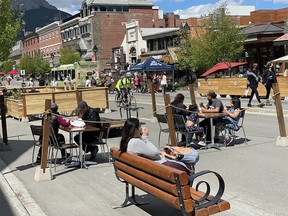The issue has polarized among Banff residents, with the council receiving dozens of letters from advocates on both sides.

.
The city of Banff is considering turning the temporary pedestrian zone seen on its main street for the past two summers into a permanent installation.
Announcement 2
.
Last week, the Banff City Council narrowly approved a hotly contested motion on the matter by a 4-3 vote, directing the administration to explore the cost of designing a permanent pedestrian area on Banff Avenue and consult with residents. on the matter.
.
The idea of closing Banff Avenue to vehicular traffic initially arose in the early days of the COVID-19 pandemic. The city banned vehicles from the two blocks at the south end of Banff Avenue during the summers of 2020 and 2021, allowing businesses and pedestrians to encroach on the roadway, to allow for proper distancing and support restaurants and local stores battling pandemic restrictions.
Earlier this year, the council approved continuing the initiative as a pilot project for the summers of 2022 and 2023 in the name of economic recovery, but currently has no plans in place beyond next summer.
Announcement 3
.
“As we look to the future, in addition to that economic resiliency, I think the conversation around the pedestrian zone should evolve to focus on environmental and sustainable tourism leadership, as well as creating people-centered public spaces,” Mayor Corrie DiManno said at a meeting on September 26.
DiManno said the move to grant the initiative permanence is exploratory in nature and not binding; she hopes it will open the discussion about the future of the busiest street in the tourist city and the place of pedestrians in it.
“Obviously there are a lot of important pieces to the pedestrian zone puzzle, especially when we’re talking about permanence,” he said. “For example, we would need more public transportation from Calgary, we would need more parking spaces outside of the city, and we would need more transportation.”
Announcement 4
.
-
Banff opens downtown street to pedestrians, with fireplace, seating and space for festivals
-
Banff’s main street will be declared a pedestrian zone, making way for sidewalk patios
-
Banff will limit cars on the main street to make room for pedestrians
The three councilmembers who voted against the motion cited the need to consult with residents before discussing potential costs.
“I think we’re forcing an issue that I don’t think is being investigated early enough,” Coun said. Hugh Pettigrew. “This is new. I think it feels like we’re pushing this and we haven’t heard from people first.
Wanda Bogdane is the Executive Director of the Banff and Lake Louise Hospitality Association, an advocacy organization that represents multiple businesses focused on tourism in Banff.
ad 5
.
“It’s exciting that Banff was able to go into a test space and assess what a future experience could be,” Bogdane said. “Certainly we’ve seen more people walking and that’s really exciting because we know that carbon-neutral transportation is the future, and this is a step in that direction.”
While he supported the initiative as a trial, Bogdane said the talk of the pedestrian area remaining “might be a little premature,” coming a year before the pilot project ends. He wants the council to assure him that the second year of the pilot program will be completed so that there is a full amount of data on which to base the decision.
“What I ask most of the council is to make sure they are doing the right thing by addressing important issues based on data and not the whims of small-scale community feedback,” he said.
ad 6
.
Traffic problems
The issue has polarized among Banff residents, with the council receiving dozens of letters from advocates on both sides, with the biggest concern raised being traffic congestion. But DiManno questioned the idea that leaving the road open would ease the city’s traffic problems.
“If we continue to reduce the number of personal vehicles crossing the bridge, it will be a win for everyone,” he said. “Cars are what cause traffic, so we need to continue to get visitors out of their cars and into public and active modes of transportation.”
City engineering director Adrian Field said Banff saw a number of successes over the summer in getting people off roadways, noting similar traffic volumes at entrances but reduced volumes on streets within the city and an increase in the number of passengers.
“We have shown this year that the tactics the council has been working on for the last 10 years or more are now working,” he said. “Arguably it works too well, because we have too many people on our buses; we have a different set of problems to solve.
“However, the direction, if we want to accommodate more visitors, it is certainly not through moving more vehicles; That can not be done.”
Twitter: @miguelrdrguez



